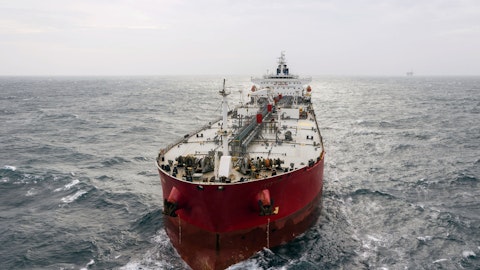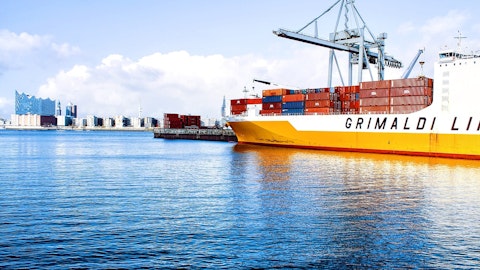Liam Burke: Great, thank you, Gary. Thank you, Costa.
Gary Vogel: Thank you.
Operator: Thank you. Our next question comes from the line of Ben Nolan with Stifel. Your line is now open.
Benjamin Nolan: Hey, thanks. Good morning guys. Gary, if I could go back to your Panama Canal stuff. I mean, obviously, there’s been a lot of noise in the market about it. And I know that as the number of transits go down, still my understanding is that the container ships are given preference. So it’s all of the other ships that are really bearing the brunt of the decline in transit. I guess my question though is, how big of a deal is it for the Supramax and Ultramax segments in particular, do you — as part of your regular business, have many ships going through there or is it just sort of on the margin?
Gary Vogel: No, it’s a meaningful part of the business, particularly for grain cargoes out of the U.S. Gulf to China and Asia. And that’s the typical trade historically. Having said that, we’re now routing ships through Suez which adds about 10 days, and it’s slightly more expensive as well, in terms of Canal dues. So that’s separate from paying auction rates for Panama. So it definitely is meaningful. The other thing is that, historically, it was fairly common for ships that were open, I’m talking about Supramax/Ultramax ships that were open on the West side, West Coast of Central America and South America to balance through the Panama Canal into a loading area, whether that would be MCSA, Columbia Coal or the U.S. Gulf. But that’s a non-starter right now.
So there’s a lack of ships that are able to get back into the Gulf in an efficient manner, which also causes a lack of available tonnage there. And it’s positive for rates coming out of the U.S. Gulf. And we have seen that just this past week. Anecdotally, we’ve fixed one of our ships out of U.S. Gulf, at a rate of $32,000, for a trip to the Far East. That again was routed via Suez.
Benjamin Nolan: Okay, that’s helpful. And then just optically, the number of charter in days that you guys have, I think it was 589 or something like that. It was meaningfully below where it was last, almost half of what it was last year, and it was even still meaningfully lower than what it was in the second quarter. Is that just the normal cyclical dynamic or maybe any color that you can give on that, on a charter and book?
Gary Vogel: Yeah, it’s good observation. I mean, essentially, the amount of short-term trading in and out, which is a fair amount of what we do is pretty static, but we had a number of charter in vessels. And given the weak market over the last number of months through the summer, those ships were redelivered, options aren’t declared. So it’s a normal ebb and flow. And then in a weaker rate environment as we take more ships on charter for whether it’s for call it three to five months with options or a year with options, you start to see that grow. And what happened previously was, as the market — as we had ships with options, and the market was strong, those options get declared. And let’s call it a base, right, for every ship that you have on period, for a quarter that’s — roughly 90 days, and what you’re seeing there is a lack of those period in ships as they were redelivered, given the weakness in the market.
Benjamin Nolan: Got it. And so as we look into the fourth quarter, obviously, you’ve announced that the rates are somewhat better than they had been. There should be, in theory, a little bit of a bounce back and then charter in as you, in theory have options that are declared, is that a fair assumption?


